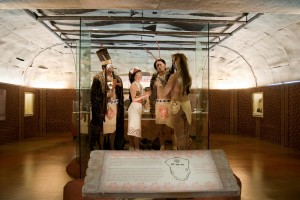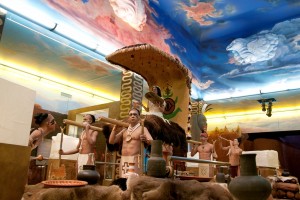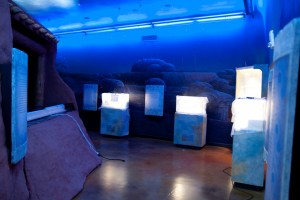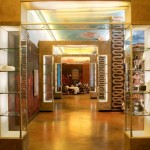NOTE: The museum will be available for preview to the media Monday, April 12. For details, contact Moundville Archaeological Park at 205/371-2234.
MOUNDVILLE, Ala. — Telling a story – that’s what a 10-year, $5 million renovation of the Jones Archaeological Museum at Moundville Archaeological Park is about. The museum, about to reopen to the public after being closed for nearly two years, combines the latest technology with more than 200 stunning artifacts to describe one of the most significant Native American archaeological sites in the United States.

“I hope visitors will get a full appreciation for how special and significant the Moundville site was and is,” said Bill Bomar, director of the Moundville Archaeological Park, part of The University of Alabama Museums. “To get that appreciation, they’re going to have to develop an understanding of how rich the culture was.”
What will visitors find? Outside, they’ll be greeted by symbols of the Native American culture mounted on enormous wooden heraldic poles. Inside, they’ll see life-size figures, drawn from life casts of contemporary Native Americans, displaying the clothing and jewelry of Mississippian cultures.
They’ll see ceremonial feather decorations hand-sewn by Native-American artists. They’ll see stunning pottery and other artworks placed in display cases that light up when recorded narratives talk about them; and they’ll encounter personally a Native American maker of medicine who appears in a reconstructed earthlodge, taking them on a journey into the afterlife.

A public celebration of the reopened museum will be from 9 a.m. to 5 p.m. Saturday, May 15. Admission will be half price on this day.
The celebration will include activities for children and adults as well as refreshments. A festival-like atmosphere will feature Native American dancers, flutists, storytellers and art demonstrations.
The renovated museum expands a well-known structure built in the 1930s by the Civilian Conservation Corps, a federal Works Progress Administration program.
The funding for the new museum came from a broad range of stakeholders including private donors, foundations, and state and federal grants.
The size of the building has nearly doubled; the structure now includes an expanded gift shop, called Knotted Bird Gifts, and a café called the Black Warrior Coffee Co. But the highlight of the new building is the three-room exhibit space that uses the latest ideas about the lives of Native American peoples in the Mississippian culture and the latest educational, interactive technology to tell the story of the people who lived at Moundville 800 years ago and to display their art.
“From the beginning, we had two overarching goals,” Bomar says. “One was to present the Moundville culture in an engaging way through immersive exhibits that told the important parts of the story. The second goal was to present the Moundville artifacts in a tasteful way that showed the sensibilities and sophistication of the people who created them. It was important for us to strike a balance between these goals.”
Moundville Archaeological Park encompasses 28 flat-topped mounds, built as platforms for civic and ceremonial buildings and the homes of the nobility in the community. The site displays the remains of a city that flourished between AD 1200 and 1450; at one point, as many as 10,000 people lived in the Black Warrior Valley under the rule of the Moundville chief.
The city served as a religious and cultural center that drew traders and residents from across what is now the southeastern United States. Archaeological excavations at the site have yielded some of the most significant pottery and other artifacts from the Mississippian culture; the history of the exploration of the site can be found here.
The Moundville city was abandoned by the time European explorers came to the area, so archaeologists have inferred what life was like there through excavations, European accounts of similar Native American cultures in the 1500s, and the knowledge and lore of contemporary Native Americans. The result: Museum developers have compiled an immersive cultural experience for visitors.

“For Moundville, the rich belief system that they had, the incredible art that they produced and the iconography and symbolism you see on that art – we knew from the beginning we’d have to fill some holes and present some theories,” Bomar says. “The challenge was to ground those theories in as much evidence as we could.”
Throughout the renovated museum, Moundville artifacts are on display in cases that allow visitors to see the fronts, backs and even the bottoms of the objects.
Many of the artifacts are owned by the University; others are borrowed from the collection of the Smithsonian Institution, including the Moundville Duck Bowl, one of the most significant artifacts ever discovered in the United States. This beautifully sculpted stone bowl was found at Moundville more than 100 years ago and has not been back in Alabama since. Murals on the walls depict what archaeologists believed happened in everyday life.
Museum exhibit designers Taft Design and Associates, headed by the husband-and-wife team of Geoffrey and Doris Woodward, were in on the planning process from the beginning. The team, which had renovated the Museum of the Cherokee Indian in North Carolina, gave the museum planners plenty of input for the renovation.

“From the beginning, they were throwing out ideas like using life casts of individuals, using audio-visual techniques and using an ‘object theater’ where the cases are connected to the multimedia so they illuminate when they’re referenced,” Bomar says.
Museum planners broke the museum into three rooms. In the central hall, visitors will encounter an upper-class bride from the central Mississippian River Valley arriving on a palanquin held by four bearers. Off to the left, in the first room, the Moundville chief and his coterie await the wedding ceremony.
Each figure is adorned in shimmering regalia including copper ornaments and a dazzling full-length feather cape. The costuming of the figures is based on real artifacts found at the Moundville site and on exhibit in surrounding cases.
“A wedding is something that all our visitors from any culture can relate to,” Bomar says. “This scene is also appropriate because it reflects recent research that shows that the Moundville people included groups who had come to the area from the west, bringing their artistic traditions with them.”
In the room to the right, a Native American medicine man, played by a Native American actor, will appear in three dimensions through a process called Pepper Ghost to tell Southeastern Indian stories about the afterlife. The three-dimensional display allows visitors to see the medicine maker perform “magic” in the form of computer-generated special effects.
The exhibit team felt that this was an important part of the story because around AD 1400, Moundville shifted from being a powerful capital city to an almost vacant ceremonial center where people were brought to be buried. Their most important symbol, the “hand and eye” is believed to represent a portal to the “path of souls.”
“Native American storytelling is an important cultural tradition,” Bomar says. “The use of modern special effects to present a traditional storyteller is quite appropriate and will really engage the visitor.”
Hours for the museum after opening will be daily from 9 a.m. to 5 p.m. Admission to the park and museum will be $8 for adults, $7 for seniors, $6 for students and children; children 5 and younger are free. Annual memberships that include free admission are available.
Native Americans’ entrance is free with a tribal membership card. Camping is $12 a night. Moundville is 13 miles south of Tuscaloosa on Alabama 69.
Contact
Bill Bomar, 205/371-2234, bbomar@bama.ua.edu; Richard LeComte, media relations, rllecomte@ur.ua.edu, 205/348-3782